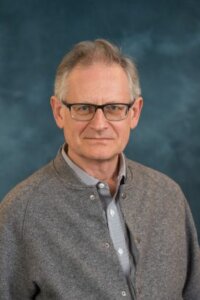The Return of Mark Epshtein, a Forgotten Master of the Yiddish Avant-Garde

Graphic by Angelie Zaslavsky
A version of this post appeared in Yiddish.
The name Mark Epshtein (1899-1949) no longer occupies a prominent place in Yiddish cultural history, but a current exhibit in Kiev brought the artist back to the city where he created his most important work. “The Return of the Master,” which runs until February 20 at the National Art Museum of Ukraine, is the first full-scale exhibition to showcase the legacy of this strange but forgotten master of the Yiddish avant-garde.
Born Moyshe Epshtein in Bobruisk, White Russia, Epshtein moved at a young age to Kiev with his family, where he entered art school. According to one story, when Epshtein was barely 10 years old, his mother sent him to bring water from the well. When he didn’t return his mother went looking for him, and found him building a sculpture of Leo Tolstoy out of snow. A neighboring photographer took a picture of the boy with his sculpture, and the picture was later was given to the Tolstoy Museum.
The story illustrates not only Epshtein’s talent and love of art, but also the tragic fate of his work. Like his childhood snowman, almost all of Epshtein’s sculptures have been lost or destroyed, with only a photographic record of them remaining. Moreover, because of his overt Jewishness Epshtein was never included in official versions of Soviet art history. Neither has he been much appreciated by Jewish art historians, presumably because his artistic vision didn’t accord with their own ideas about Jewish art.
Yet Epshtein was a gifted painter, graphic artist, sculptor and social activist. In 1917 he became one of the founders of the Kiev Kultur-lige (Culture League), a group of Yiddish-speaking artists, writers and intellectuals committed to the development of Yiddish culture. Epshtein created the group’s art section and organized its first exhibit. After the Kultur-lige came under Soviet control in 1920 Epshtein remained in Kiev, though many of the city’s artists and writers left for greater opportunities in Moscow or abroad. From 1923 to 1931 Epshtein served as the director of Kiev’s Jewish School of Industrial Art, the only institution that continued the Yiddish modernist tradition.
Epshtein belonged to a generation of Jewish artists that was attempting to combine Yiddish folk art with avant-garde influences in order to create a modern Yiddish style. Some of Epshtein’s Kiev colleagues became world famous, including artists such as Marc Chagall and El Lissitzky. But Epshtein remained committed to the mission of the Kultur-lige, even under Soviet control.
All studies in the Kiev school were conducted entirely in Yiddish, and Epshtein required his students to create work that was immediately recognizable as Jewish. In the recollections of his students he was a strict teacher, but with a melancholy temperament and not very talkative. Even at the age of 30 he looked like an older man, dressed formally in the European style.
In his own artistic development, Epshtein explored styles such as Impressionism, Cubism, Constructivism and Primitivism. As the Ukrainian art historian Sergei Papeta has noted, Epshtein’s style achieved maturity at the end of the 1920s, when he had absorbed all the influences of the time.
Epshtein‘s work from that period combined a realistic portrayal of human types together with sharp analytic insight, which depicted the historical moment between the decline of shtetl life and the rise of a new Jewish, urban working class in the Soviet Union. His subjects are often manual laborers possessing a brute physicality, although they are occasionally artists or musicians. The series of portraits he created of Jewish peasants, workers and tradesmen created a collective image of uncultivated Soviet Jews at a time of radical transformation.
In the 1930s, however, Epshtein fell out favor with the Soviet establishment, which demanded adherence to the new style of Social Realism. After he had been sharply criticized for “formalism,” he moved to Moscow and supported himself by working on official Soviet monuments. As an artist he had exhausted himself and he died in poverty, his work given over to the museum in Kiev, where it was dispersed piecemeal.
While Epshtein has largely been forgotten, it is noteworthy that a resurgence of interest in his work, as well as in the rest of the Kiev group, is taking place in Ukraine. There, Epshtein and his colleagues are understood by critics and art historians not just as Jewish artists, but also as part of Ukraine’s art history and an element of the country’s modernist movement. Certainly, it behooves the Jewish art establishment to take at least as keen an interest in their own cultural inheritance.
Translated by Ezra Glinter

















